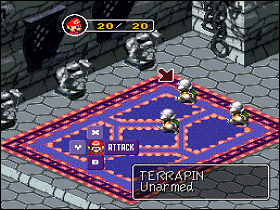 The Game: The seemingly endless battle between Mario and Bowser continues with the Koopa king’s latest kidnapping of the princess. A fierce battle ensues in Bowser’s castle, ending with what seems like a swift defeat for Bowser, when another combatant appears: a huge sword from the sky impales the castle, driving both Mario and Bowser out and preventing them from returning. Mario has to embark on an extended quest through the Mushroom Kingdom and other realms, gradually accumulating a band of locals to help him fight his way through the perils he meets along the way. He has to recover the seven pieces of the Star Road before he can resume his battle against the Smithy Gang bent on taking over his world. (Nintendo / Square, 1996)
The Game: The seemingly endless battle between Mario and Bowser continues with the Koopa king’s latest kidnapping of the princess. A fierce battle ensues in Bowser’s castle, ending with what seems like a swift defeat for Bowser, when another combatant appears: a huge sword from the sky impales the castle, driving both Mario and Bowser out and preventing them from returning. Mario has to embark on an extended quest through the Mushroom Kingdom and other realms, gradually accumulating a band of locals to help him fight his way through the perils he meets along the way. He has to recover the seven pieces of the Star Road before he can resume his battle against the Smithy Gang bent on taking over his world. (Nintendo / Square, 1996)
Memories: An unlikely joint project between ’90s RPG powerhouse Square and Nintendo, this game took the universe of Super Mario Bros. and overlaid it on the action RPG structure that both companies had made famous and evolved over the previous decade. As strange as it was to try to get one’s head around a Mario game with a combat system and a “special items” menu, Super Mario RPG actually works beautifully.
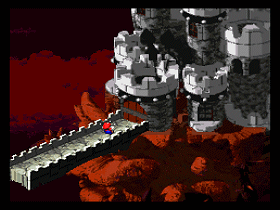 And it doesn’t look or sound bad either – for quite a while, this was the gold standard for a game set in the Marioverse; even later attempts to drag Super Mario Bros. into 3-D rendered graphics on the N64 didn’t have the beauty and level of detail in Super Mario RPG. The music is hummable and drags you into the game’s world effectively, and only refers to the well-worn tunes from previous entries in the Super Mario franchise occasionally. So many Mario games had spent so much time making inside-joke references to the previous games in the series that Super Mario RPG was a novelty simply because of how much it didn’t do that.
And it doesn’t look or sound bad either – for quite a while, this was the gold standard for a game set in the Marioverse; even later attempts to drag Super Mario Bros. into 3-D rendered graphics on the N64 didn’t have the beauty and level of detail in Super Mario RPG. The music is hummable and drags you into the game’s world effectively, and only refers to the well-worn tunes from previous entries in the Super Mario franchise occasionally. So many Mario games had spent so much time making inside-joke references to the previous games in the series that Super Mario RPG was a novelty simply because of how much it didn’t do that.
As a game play experience, it’s effective and addictive. A simple menu system makes good use of the ocean of buttons on the SNES controller, and it quickly gets to be second nature, which is a good thing – even during the turn-based combat segments, players can affect the outcome of their battles with carefully timed control combos, keeping the turn-based fights from being a boring necessity. The non-combat majority of the game is free-flowing, 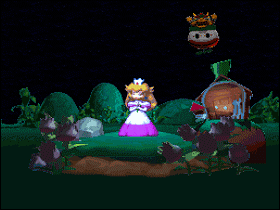 nicely animated, and just plain pretty to look at. Even with the N64’s superior graphics hardware, it would be a long time before a Mario game came along to top this one.
nicely animated, and just plain pretty to look at. Even with the N64’s superior graphics hardware, it would be a long time before a Mario game came along to top this one.
With this gourmet recipe for greatness, it was therefore only natural that Square and Nintendo had a parting of the ways after Super Mario RPG, primarily over Square’s desire to carry its Final Fantasy franchise over to the then-new Sony Playstation. The result was that it would be five years before there was a successor to Super Mario RPG, and even then it couldn’t use the same structure, conventions and characters from the previous game. The resulting Paper Mario series has become a success in its own right, but the debate continues as to whether 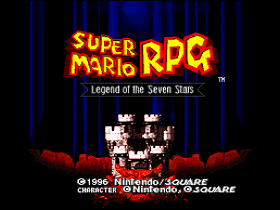 or not it’s ever attained the shining-moment-of-greatness that Super Mario RPG was for so many years – when this game arrived on the Wii Virtual Console, it was a Big Deal to those who remembered it so fondly.
or not it’s ever attained the shining-moment-of-greatness that Super Mario RPG was for so many years – when this game arrived on the Wii Virtual Console, it was a Big Deal to those who remembered it so fondly.
 Super Mario RPG was a singular event in the development of the Super Mario franchise, offering a fresh take on the familiar characters and settings, while introducing an entire world’s worth of new places and characters. In many ways it’s still one of the high points.[read more]
Super Mario RPG was a singular event in the development of the Super Mario franchise, offering a fresh take on the familiar characters and settings, while introducing an entire world’s worth of new places and characters. In many ways it’s still one of the high points.[read more]
 The Game: Players start with a blank slate of a land mass, a budget, and their hopes and dreams. The building of a city begins (usually with a power plant of some kind), a delicate attempt to balance residential, commercial, and industrial space, transportation systems, demands from the public, and tax rates. The city will flourish, stagnate, or empty out and completely fail depending upon the player’s mayoral choices. (Nintendo/Maxis, 1991)
The Game: Players start with a blank slate of a land mass, a budget, and their hopes and dreams. The building of a city begins (usually with a power plant of some kind), a delicate attempt to balance residential, commercial, and industrial space, transportation systems, demands from the public, and tax rates. The city will flourish, stagnate, or empty out and completely fail depending upon the player’s mayoral choices. (Nintendo/Maxis, 1991)
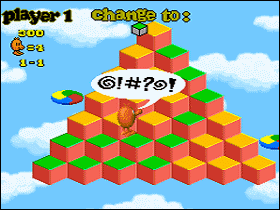 The Game: Q*Bert, a nosey little guy with a propensity for hopping, spends his time hopping around a three-dimensional pyramid of cubes, avoiding Coily the Snake and other assorted purple and red creatures, including a few who operate on a slightly different plane (i.e., they move down the pyramid as if it were rotated one-third). Changing the colors of the top of every cube in the pyramid to the target color indicated at the top left of the screen will clear the pyramid and start the craziness all over again. If Q*Bert is hit by an enemy or falls off the pyramid, he hits bottom with a resounding, arcade- cabinet-shaking splat and a burst of incomprehensible obscenity! (NTVIC, 1992)
The Game: Q*Bert, a nosey little guy with a propensity for hopping, spends his time hopping around a three-dimensional pyramid of cubes, avoiding Coily the Snake and other assorted purple and red creatures, including a few who operate on a slightly different plane (i.e., they move down the pyramid as if it were rotated one-third). Changing the colors of the top of every cube in the pyramid to the target color indicated at the top left of the screen will clear the pyramid and start the craziness all over again. If Q*Bert is hit by an enemy or falls off the pyramid, he hits bottom with a resounding, arcade- cabinet-shaking splat and a burst of incomprehensible obscenity! (NTVIC, 1992)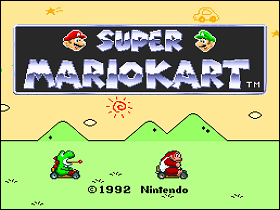 The Game: It’s a big day at the races, with a field of drivers selected from the Mushroom Kingdom: Mario, Luigi, Princess Peach, Toad, Bowser, and even Donkey Kong Jr. are among the racers vying for the top spot. From the grassy Mushroom course to the punishingly muddy Star course to the oceanside Flower course, there are challenges, hairpin turns and obstacles. Whoever can learn to navigate each course the fastest without ending up out of bounds struggling to get back on the course will be the winner. (Nintendo, 1992)
The Game: It’s a big day at the races, with a field of drivers selected from the Mushroom Kingdom: Mario, Luigi, Princess Peach, Toad, Bowser, and even Donkey Kong Jr. are among the racers vying for the top spot. From the grassy Mushroom course to the punishingly muddy Star course to the oceanside Flower course, there are challenges, hairpin turns and obstacles. Whoever can learn to navigate each course the fastest without ending up out of bounds struggling to get back on the course will be the winner. (Nintendo, 1992)
 The Game: The seemingly endless battle between Mario and Bowser continues with the Koopa king’s latest kidnapping of the princess. A fierce battle ensues in Bowser’s castle, ending with what seems like a swift defeat for Bowser, when another combatant appears: a huge sword from the sky impales the castle, driving both Mario and Bowser out and preventing them from returning. Mario has to embark on an extended quest through the Mushroom Kingdom and other realms, gradually accumulating a band of locals to help him fight his way through the perils he meets along the way. He has to recover the seven pieces of the Star Road before he can resume his battle against the Smithy Gang bent on taking over his world. (Nintendo / Square, 1996)
The Game: The seemingly endless battle between Mario and Bowser continues with the Koopa king’s latest kidnapping of the princess. A fierce battle ensues in Bowser’s castle, ending with what seems like a swift defeat for Bowser, when another combatant appears: a huge sword from the sky impales the castle, driving both Mario and Bowser out and preventing them from returning. Mario has to embark on an extended quest through the Mushroom Kingdom and other realms, gradually accumulating a band of locals to help him fight his way through the perils he meets along the way. He has to recover the seven pieces of the Star Road before he can resume his battle against the Smithy Gang bent on taking over his world. (Nintendo / Square, 1996) And it doesn’t look or sound bad either – for quite a while, this was the gold standard for a game set in the Marioverse; even later attempts to drag Super Mario Bros. into 3-D rendered graphics on the N64 didn’t have the beauty and level of detail in Super Mario RPG. The music is hummable and drags you into the game’s world effectively, and only refers to the well-worn tunes from previous entries in the Super Mario franchise occasionally. So many Mario games had spent so much time making inside-joke references to the previous games in the series that Super Mario RPG was a novelty simply because of how much it didn’t do that.
And it doesn’t look or sound bad either – for quite a while, this was the gold standard for a game set in the Marioverse; even later attempts to drag Super Mario Bros. into 3-D rendered graphics on the N64 didn’t have the beauty and level of detail in Super Mario RPG. The music is hummable and drags you into the game’s world effectively, and only refers to the well-worn tunes from previous entries in the Super Mario franchise occasionally. So many Mario games had spent so much time making inside-joke references to the previous games in the series that Super Mario RPG was a novelty simply because of how much it didn’t do that. nicely animated, and just plain pretty to look at. Even with the N64’s superior graphics hardware, it would be a long time before a Mario game came along to top this one.
nicely animated, and just plain pretty to look at. Even with the N64’s superior graphics hardware, it would be a long time before a Mario game came along to top this one. or not it’s ever attained the shining-moment-of-greatness that Super Mario RPG was for so many years – when this game arrived on the Wii Virtual Console, it was a Big Deal to those who remembered it so fondly.
or not it’s ever attained the shining-moment-of-greatness that Super Mario RPG was for so many years – when this game arrived on the Wii Virtual Console, it was a Big Deal to those who remembered it so fondly. Super Mario RPG was a singular event in the development of the Super Mario franchise, offering a fresh take on the familiar characters and settings, while introducing an entire world’s worth of new places and characters. In many ways it’s still one of the high points.[read more]
Super Mario RPG was a singular event in the development of the Super Mario franchise, offering a fresh take on the familiar characters and settings, while introducing an entire world’s worth of new places and characters. In many ways it’s still one of the high points.[read more]